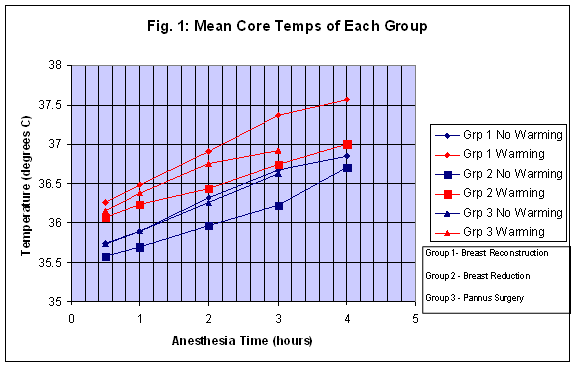Wednesday, October 31, 2007
13156
The Effect of Preoperative Warming of the Patient in Plastic Surgery Operations
Purpose: Operative procedures under general anesthesia create a patient environment that predisposes the patient to hypothermia. To prevent hypothermia we use prep and drape techniques to minimize patient exposure, warmed IV fluids, warmed irrigation fluids, forced air warming blankets, low flow and humidified general anesthesia circuits. Since November 2006, we have added preoperative warming of the patient using a forced air heating blanket for at least 30 minutes before transfer to the operating room. This study is a retrospective chart review looking at the effectiveness of this technique.
Methods: The study examines three operative procedures: mastectomy and immediate reconstruction with implant, bilateral breast reduction, and abdominal pannus surgery performed by one surgeon. Consecutive patients for each procedure type were evaluated starting from the time of addition of pre-op warming and counting forward and counting backward in time for the control group. Fifty-four patients were included in the study. There were eighteen patients for breast reconstruction, twenty patients for breast reduction, and sixteen patients for pannus surgery. Half of each procedure group had preoperative warming and half did not- control group. Data was obtained from the anesthesia record. Only core temperature measurements are reported and were measured using esophageal temperature probe. The temperatures reported were: lowest temperature during the operation and its time, temperature at 1 hr, 2 hr, 3hr, 4 hr and temperature at end of surgery. Preoperative warming needed to be for at least 30 minutes using a forced air total body warming blanket.
Results: There were no complications related to the use of the forced air heating blanket. The average age, height and weight were similar for each of the pre-warming groups compared to their control groups.

Fig. 1 shows the 6 different groups mean temperature plotted versus time. The lowest temperature was at 30 – 45 minutes following start of surgery and then slowly increased with time. All the pre-warmed patient groups averaged higher temperature than their controls. The biggest difference was in the breast reconstruction group and smallest in the pannus surgery group.

Fig. 2 shows mean temperature for all the pre-warming patients versus all the control patients and their relation to 36.0 degrees centigrade. The pre-warming group was 0.5 degree warmer at all times.

Fig. 3 shows the percentage of patients that were at or above 36 degrees C. at any time period. This showed that pre-warming was effective in keeping the temperature from dropping below 36 degrees C., especially in the first hour of surgery.
Discussion: Higher postoperative complication rates have been reported with mild hypothermia- core temperature of 34 to 36 degrees C. These include infection, bleeding, cardiac events, longer hospitalization, thermal discomfort, duration of post anesthesia recovery. These are well summarized in review articles by Sessler (1) and Young (2). Thus, the goal would be to maintain the patient's core temperature above 36.0 degrees C. Fig #3 shows that preoperative warming was successful, but did not completely prevent mild hypothermia. Our intra-operative warming techniques were successful as patient temperatures rose as the surgery progressed and only 2 patients had core temperatures under 36 degrees C at the end of the operation;( both in the control group).
The ambient temperature of the operating room ranged between 66.5 and 69 degrees F. Warming the operating room has been shown to prevent hypothermia, we did not attempt to change this variable.
We have found no change in complication rates as a result of preoperative warming. A larger patient population group would need to be studied to determine any significant difference in outcomes.
Conclusion: Pre-operative warming is effective technique in preventing mild hypothermia in plastic surgery patients when used along with other prevention strategies.
1. Sessler, DI. Complications and Treatment of Mild Hypothermia; Anesthesiology Aug 2001; 95 (2) : 531-543
2. Young, VL. Prevention of Perioperative Hypothermia in Plastic Surgery; Aesthetic Surgery Sept 2006, 26 (5): 551-571
View Synopsis (.doc format, 40.0 kb)
See more of General Reconstruction
Back to 2007am Complete Scientific Program
